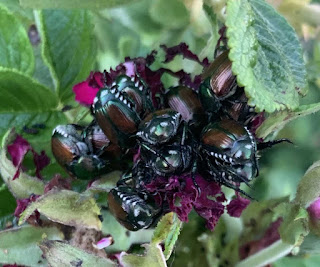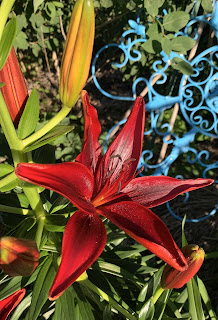
Slowly and stealthly, the sly hunter stalks his prey beneath the searing sun. He knows this foe, has studied its habits, sought out its secrets. Bare hands and intellect his only, but most lethal weapons, sufficient for the moment. Each perforated petal, each sullied sepal, mere arrows pellucidly pointing to the presence of another plump
Popillia. The beast hides at night, beneath flowers folded for shelter. At morning, the target is torpid, stuporous and stuffed by the night's chill and previous evening meal, difficult to find, but easily caught and easily dispatched. But as the sun rises, so the creature is ever more foolhardy, warming to feast and fornicate, flinging frass over flower. Brazenly breeding without heed to predator or voyeur in the daylight, it lives to eat, procreate, and preferentially die at the hands of the ancient hunter, the latter ever more determined, ever more skilled, at beetle genocide.
ProfessorRoush has spent several days now, morning and evening, examining the garden flower by flower, foliage by foliage, as intent to his purpose and unaware of its ultimate futility as Custer at the Little Big Horn. After my initial discovery of the beetle re-invasion, I found more of the insects that very evening, lots more, and I've found a few every day since. During the past few days, the beetle numbers are dwindling, and yet, my skill at finding them seems to improve every hour. I subsequently feel responsible to pass on my hard-earned hunting skills.
Initially, I concentrated on the beetles lounging without care in the center of my flowers, swiping them into the palm of my bare hand even, as disgusting as it sounds, while they were paired
in flagrante delicto. As quickly as I could, I then dropped them onto the stones edging my garden beds and gleefully stomped them into beetle pulp.
I know it sounds barbaric, but I have to truthfully state that the crunch of a beetle shell brings a smile to my face every time, a brief moment of insectopathic glee.
But I have learned, as all great hunters before me, to stalk the dwindling prey less by sight and more by stealth. I recognized quickly that beetles were often hiding beneath petals that had holes chewed in them. Look at the perforated flower at the upper left. A slight change in elevation and angle to the view of the same flower at the right, and
voila, one finds the culprit hiding in the shade, easily collected and dispatched. And I've given up beetle crunching, time-consuming and ultimately, probably, detrimental to my Karma, in favor of the time-tested method of knocking them into a cup of soapy water, to drown in silence.

I've also learned to read "sign," a polite hunting term that refers to the technique of following the poop trail of a prey animal to its lair. The droppings of an insect are more properly known as "frass," and Japanese Beetles leave more then their fair share behind, wallowing, eating and fornicating with glee right in the midst of it, like chitinous pigs at the county fair. At the lower right of the picture of Blanc Double de Coubert on the left, you can see frass on the petal there. Where there is frass, there are beetles. I have also decided that it is much more sanitary to sweep the frass along with the beetle into the soapy water of a cup, rather than into my hand.
For the time-being, those are the best lessons for beetle-genocide that my vast experience can pass on. I suppose I could erect a wall that reaches above their flight paths, perhaps even cover it in solar panels, but then I'd be making a social statement rather than a gardening one. Good luck to everyone in your own beetle battles.
I also hereby apologize for
my previous aspersions against Blanc Double de Coubert and her beetle magnetism. I've since found beetles on 7 individual roses, and so, while Blanc remains the beetle champion, she's not the only one to blame for luring them into my garden.



.jpg)
.jpg)
.jpg)
.jpg)
.jpg)
.jpg)
.jpg)
.jpg)
.jpg)
.jpg)
.jpg)
.jpg)
.jpg)
.jpg)
.jpg)
.jpg)




























.jpg)

.jpg)
